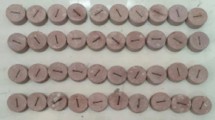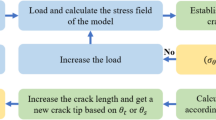Abstract
A three-dimensional coupled thermomechanical model is proposed which can simulate crack initiation, propagation and coalescence, as well as the distribution of stress and temperature during thermal cracking. The model consists of two parts: The temperature distribution of the system is calculated according to the heat conduction equation, the thermal stress caused by temperature is applied to the system equation and a mechanical calculation considering cracking is performed. Three examples are given to verify the model regarding the problems of heat conduction, thermomechanical coupling and thermal cracking. This model has the potential to be applied to geothermal or oil exploitation and nuclear waste disposal.
























Similar content being viewed by others
References
Thirumalai K, Demou SG (1970) Effect of reduced pressure on thermal-expansion behavior of rocks and its significance to thermal fragmentation. J Appl Phys 41(13):5147–5151. https://doi.org/10.1063/1.1658636
Johnson B, Gangi AF, Handin J (1978) Thermal cracking of rock subjected to slow, Uniform Temperature Changes. 1978/1/1
Lo KY, Wai RSC (1982) Thermal expansion, diffusivity, and cracking of rock cores from Darlington, Ontario. Can Geotech J 19(2):154–166. https://doi.org/10.1139/t82-017
Chernis P, Robertson P (1993) Thermal cracking in Lac du Bonnet granite during slow heating to 205 degrees celsius
Mahmutoglu Y (1998) Mechanical behaviour of cyclically heated fine grained rock. Rock Mech Rock Eng 31:169–179
Dwivedi RD, Goel RK, Prasad VVR, Sinha A (2008) Thermo-mechanical properties of Indian and other granites. Int J Rock Mech Min Sci 45(3):303–315. https://doi.org/10.1016/j.ijrmms.2007.05.008
Favero V, Ferrari A, Laloui L (2016) Thermo-mechanical volume change behaviour of Opalinus Clay. Int J Rock Mech Min Sci 90:15–25. https://doi.org/10.1016/j.ijrmms.2016.09.013
Gawin D, Pesavento F, Schrefler BA (2003) Modelling of hygro-thermal behaviour of concrete at high temperature with thermo-chemical and mechanical material degradation. Comput Methods Appl Mech Eng 192(13–14):1731–1771. https://doi.org/10.1016/s0045-7825(03)00200-7
Luccioni BM, Figueroa MI, Danesi RF (2003) Thermo-mechanic model for concrete exposed to elevated temperatures. Eng Struct 25(6):729–742. https://doi.org/10.1016/s0141-0296(02)00209-2
Sasaki T, Morikawa S (1996) Thermo-mechanical consolidation coupling analysis on jointed rock mass by the finite element method. Eng Comput 13(7):70–86. https://doi.org/10.1108/02644409610151566
Lee H-S, Jing L (2004) An inverse stress reconstruction algorithm for modelling excavation and thermo-mechanical effects of rock structures. Eng Anal Bound Elem 28(7):833–842. https://doi.org/10.1016/j.enganabound.2003.12.004
Fu YF, Wong YL, Tang CA, Poon CS (2004) Thermal induced stress and associated cracking in cement-based composite at elevated temperatures—Part I: thermal cracking around single inclusion. Cement Concr Compos 26(2):99–111. https://doi.org/10.1016/s0958-9465(03)00086-6
Tang SB, Tang CA, Li LC, Liang ZZ (2009) Numerical approach on the thermo-mechanical coupling of brittle material. Chin J Comput Mech 26(2):172–179
Tang SB, Tang CA, Zhu WC, Wang SH, Yu QL (2006) Numerical investigation on rock failure process induced by thermal stress. Chin J Rock Mech Eng 25(10):2071–2078
Tang SB, Tang CA (2015) Crack propagation and coalescence in quasi-brittle materials at high temperatures. Eng Fract Mech 134:404–432. https://doi.org/10.1016/j.engfracmech.2015.01.001
Tang SB, Zhang H, Tang CA, Liu HY (2016) Numerical model for the cracking behavior of heterogeneous brittle solids subjected to thermal shock. Int J Solids Struct 80:520–531. https://doi.org/10.1016/j.ijsolstr.2015.10.012
Jiao Y-Y, Zhang X-L, Zhang H-Q, Li H-B, Yang S-Q, Li J-C (2015) A coupled thermo-mechanical discontinuum model for simulating rock cracking induced by temperature stresses. Comput Geotech 67:142–149. https://doi.org/10.1016/j.compgeo.2015.03.009
Wanne TS, Young RP (2008) Bonded-particle modeling of thermally fractured granite. Int J Rock Mech Min Sci 45(5):789–799. https://doi.org/10.1016/j.ijrmms.2007.09.004
Xia M (2015) Thermo-mechanical coupled particle model for rock. Trans Nonferrous Met Soc China 25(7):2367–2379. https://doi.org/10.1016/s1003-6326(15)63852-3
André D, Levraut B, Tessier-Doyen N, Huger M (2017) A discrete element thermo-mechanical modelling of diffuse damage induced by thermal expansion mismatch of two-phase materials. Comput Methods Appl Mech Eng 318:898–916. https://doi.org/10.1016/j.cma.2017.01.029
Nechnech W, Meftah F, Reynouard JM (2002) An elasto-plastic damage model for plain concrete subjected to high temperatures. Eng Struct 24:597–611
Sun Y, Liew KM (2017) Modeling of thermo-mechanical fracture behaviors based on cohesive segments formulation. Eng Anal Bound Elem 77:81–88. https://doi.org/10.1016/j.enganabound.2017.01.007
Tenchev R, Purnell P (2005) An application of a damage constitutive model to concrete at high temperature and prediction of spalling. Int J Solids Struct 42(26):6550–6565. https://doi.org/10.1016/j.ijsolstr.2005.06.016
Ghazvinian E, Diederichs MS, Quey R (2014) 3D random Voronoi grain-based models for simulation of brittle rock damage and fabric-guided micro-fracturing. J Rock Mech Geotech Eng 6(6):506–521. https://doi.org/10.1016/j.jrmge.2014.09.001
Munjiza A, Owen DRJ, Bicanic N (1995) A combined finite-discrete element method in transient dynamics of fracturing solids. Eng Comput 12(2):145–174. https://doi.org/10.1108/02644409510799532
Munjiza A, Latham JP, Andrews KRF (1999) Challenges of a coupled combined finite-discrete element approach to explosive induced rock fragmentation. Fragblast 3(3):237–250. https://doi.org/10.1080/13855149909408048
Munjiza A (2004) The combined finite-discrete element method. Wiley, London
Mahabadi O, Kaifosh P, Marschall P, Vietor T (2014) Three-dimensional FDEM numerical simulation of failure processes observed in Opalinus Clay laboratory samples. J Rock Mech Geotech Eng 6(6):591–606. https://doi.org/10.1016/j.jrmge.2014.10.005
Lisjak A, Grasselli G, Vietor T (2014) Continuum–discontinuum analysis of failure mechanisms around unsupported circular excavations in anisotropic clay shales. Int J Rock Mech Min Sci 65:96–115. https://doi.org/10.1016/j.ijrmms.2013.10.006
Tatone BSA, Grasselli G (2015) A calibration procedure for two-dimensional laboratory-scale hybrid finite–discrete element simulations. Int J Rock Mech Min Sci 75:56–72. https://doi.org/10.1016/j.ijrmms.2015.01.011
Rougier E, Knight EE (2015) Recent developments in the combined finite discrete element method. In: Paper presented at the 1st Pan-American congress on computational mechanics—PANACM
Lei Z, Rougier E, Knight EE, Munjiza A (2015) FDEM simulation on fracture coalescence in brittle materials. In: Paper presented at the 49th US rock mechanics/geomechanics symposium
Lei Z, Rougier E, Knight EE, Munjiza A (2014) A framework for grand scale parallelization of the combined finite discrete element method in 2d. Comput Part Mech 1(3):307–319. https://doi.org/10.1007/s40571-014-0026-3
Fukuda D, Mohammadnejad M, Liu H, Dehkhoda S, Chan A, Cho SH, Min GJ, Han H, Ji Kodama, Fujii Y (2019) Development of a GPGPU-parallelized hybrid finite-discrete element method for modeling rock fracture. Int J Numer Anal Meth Geomech. https://doi.org/10.1002/nag.2934
Yan C, Jiao Y-Y, Yang S (2018) A 2D coupled hydro-thermal model for the combined finite-discrete element method. Acta Geotech. https://doi.org/10.1007/s11440-018-0653-6
Lisjak A, Mahabadi OK, He L, Tatone BSA, Kaifosh P, Haque SA, Grasselli G (2018) Acceleration of a 2D/3D finite-discrete element code for geomechanical simulations using general purpose GPU computing. Comput Geotech 100:84–96. https://doi.org/10.1016/j.compgeo.2018.04.011
Vazaios I, Diederichs MS, Vlachopoulos N (2019) Assessment of strain bursting in deep tunnelling by using the finite-discrete element method. J Rock Mech Geotech Eng 11(1):12–37. https://doi.org/10.1016/j.jrmge.2018.06.007
Li X, Kim E, Walton G (2019) A study of rock pillar behaviors in laboratory and in situ scales using combined finite-discrete element method models. Int J Rock Mech Min Sci 118:21–32. https://doi.org/10.1016/j.ijrmms.2019.03.030
Yan C, Jiao Y-Y (2019) A 2D discrete heat transfer model considering the thermal resistance effect of fractures for simulating the thermal cracking of brittle materials. Acta Geotechnica. https://doi.org/10.1007/s11440-019-00821-x.
Yan C, Zheng H (2017) A new potential function for the calculation of contact forces in the combined finite–discrete element method. Int J Numer Anal Methods Geomech 41(2):265–283
Yan C, Zheng H, Sun G, Ge X (2016) Combined finite-discrete element method for simulation of hydraulic fracturing. Rock Mech Rock Eng 49(4):1389–1410. https://doi.org/10.1007/s00603-015-0816-9
Yan C, Zheng H (2016) A two-dimensional coupled hydro-mechanical finite-discrete model considering porous media flow for simulating hydraulic fracturing. Int J Rock Mech Min Sci 88:115–128. https://doi.org/10.1016/j.ijrmms.2016.07.019
Yan C, Zheng H (2017) FDEM-flow3D: a 3D hydro-mechanical coupled model considering the pore seepage of rock matrix for simulating three-dimensional hydraulic fracturing. Comput Geotech 81:212–228. https://doi.org/10.1016/j.compgeo.2016.08.014
Yan C, Zheng H (2017) Three-Dimensional hydromechanical model of hydraulic fracturing with arbitrarily discrete fracture networks using finite-discrete element method. Int J Geomech 17(6):04016133
Yan C, Jiao Y-Y (2018) A 2D fully coupled hydro-mechanical finite-discrete element model with real pore seepage for simulating the deformation and fracture of porous medium driven by fluid. Comput Struct 196:311–326. https://doi.org/10.1016/j.compstruc.2017.10.005
Yan C, Jiao Y-Y, Zheng H (2018) A fully coupled three-dimensional hydro-mechanical finite discrete element approach with real porous seepage for simulating 3D hydraulic fracturing. Comput Geotech 96:73–89. https://doi.org/10.1016/j.compgeo.2017.10.008
Lei Z, Rougier E, Munjiza A, Viswanathan H, Knight EE (2019) Simulation of discrete cracks driven by nearly incompressible fluid via 2D combined finite-discrete element method. Int J Numer Anal Methods Geomech. https://doi.org/10.1002/nag.2929
Ha J, Lisjak A, Grasselli G (2015) FDEM modelling of thermo-mechanical wellbore instabilities within shale formations. In: Paper presented at the 49th US rock mechanics/geomechanics symposium
Joulin C, Xiang J, Latham J-P, Pain C (2016) A new finite discrete element approach for heat transfer in complex shaped multi bodied contact problems. In: International conference on discrete element methods, Springer, New York, pp 311–327
Guo L, Xiang J, Latham J-P, Izzuddin B (2016) A numerical investigation of mesh sensitivity for a new three-dimensional fracture model within the combined finite-discrete element method. Eng Fract Mech 151:70–91. https://doi.org/10.1016/j.engfracmech.2015.11.006
Munjiza A, Andrews K, White J (1999) Combined single and smeared crack model in combined finite-discrete element analysis. Int J Numer Methods Eng 44(1):41–57
Munjiza A, Andrews KRF (1998) NBS contact detection algorithm for bodies of similar size. Int J Numer Methods Eng 43(1):131–149
Munjiza A, Rougier E, John NWM (2006) MR linear contact detection algorithm. Int J Numer Methods Eng 66(1):46–71. https://doi.org/10.1002/nme.1538
Munjiza AA, Andrews KRF, White JK (2000) Penalty function method for combined finite-discrete element systems comprising large number of separate bodies. Int J Numer Methods Eng 49(11):1377–1396
Munjiza A (2011) Computational mechanics of Discontinua. Wiley, Hoboken
Lei Z, Zang M, Munjiza A (2010) Implementation of combined single and smeared crack model in 3D combined finite-discrete element analysis. In: Discrete element methods–simulation of Discontinua: theory and applications, London, UK, pp 102–107
Lisjak A, Tatone BSA, Mahabadi OK, Grasselli G, Marschall P, Lanyon GW, Rdl Vaissière, Shao H, Leung H, Nussbaum C (2016) Hybrid finite-discrete element simulation of the EDZ formation and mechanical sealing process around a microtunnel in Opalinus Clay. Rock Mech Rock Eng 49(5):1849–1873. https://doi.org/10.1007/s00603-015-0847-2
Itasca (2005) Consulting Group Inc., Code 3DEC. User’s Guide, Minnesota, USA
Bergman TL, Incropera FP (2011) Fundamentals of heat and mass transfer. Wiley, Hoboken
Geuzaine C, Remacle JF (2009) Gmsh: a 3-D finite element mesh generator with built-in pre-and post-processing facilities. Int J Numer Meth Eng 79(11):1309–1331
Nowacki W (1962) Thermoelasticity. Addison-Wesley, New York
Tang SB (2005) Numerical model for thermal cracking process of rock and its application. Dissertation, Northeastern University
Acknowledgements
This work has been supported by the National Natural Science Foundation of China under the Grant Nos. 11872340 and 11602006; the Fundamental Research Funds for the Central Universities, China University of Geosciences (Wuhan) (CUG170657); the National Natural Science Foundation of China under the Grant No. 41731284.
Author information
Authors and Affiliations
Corresponding author
Additional information
Publisher's Note
Springer Nature remains neutral with regard to jurisdictional claims in published maps and institutional affiliations.
Rights and permissions
About this article
Cite this article
Yan, C., Ren, Y. & Yang, Y. A 3D thermal cracking model for rockbased on the combined finite–discrete element method. Comp. Part. Mech. 7, 881–901 (2020). https://doi.org/10.1007/s40571-019-00281-w
Received:
Revised:
Accepted:
Published:
Issue Date:
DOI: https://doi.org/10.1007/s40571-019-00281-w




